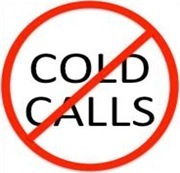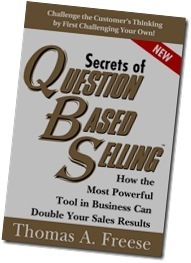Stop Making “Cold” Calls, Please…
When contacting new prospects for the very first time, wouldn’t it be great to have a 30% to 50% success rate instead of the standard 1% to 2%? Think about it. If only one or two out of a hundred people actually chooses to engage with you, with the rest of your opportunities going down in flames, it almost seems inhumane to ask someone to continue making that many calls with such a low success rate.
It turns out that making cold calls in 2014 is a bad strategy. It’s also a colossal waste of time and energy for sales teams moving forward. Salespeople hate to make them because they incur such a high rate of rejection, and customers hate to take cold calls because they perceive them as useless wastes of time. Consequently, cold calling tends to produce an extremely low return on invested sales effort (ROISE).
Now, I‘m not saying you shouldn’t call prospective customers, nor am I suggesting that you make fewer calls or work less. I’m just saying that you shouldn’t make “cold” calls any more. Fortunately, there is a better way.
What’s the problem with a cold call? The answer is simple: Temperature. Cold calls tend to sound vague and purposeless, rather than valuable, credible or relevant to the person on the receiving end of the call. So, what do you suppose the chances of making a sale are if the customer’s first impression is that this call is probably going to be a waste of time? Perhaps I should just come right out and ask: When is a good time for you to take cold calls from a salesperson you don’t yet know or trust? I think you’d say that it’s never a good time. But, what if it was possible to change the customer’s mentality to be more receptive to your calls?
Let me give you a sample of what a cold call typically sounds like:
Salesperson: “Good afternoon, Mr. Customer, my name is Joe Smith and I’m with Equitable Real Estate Life Insurance Mortgage Company. I wanted to introduce myself and see if there would be a good time to set up a meeting so I can show you how our products could help you manage your short-term monetary goals and well as help with your longer-term financial planning.
Customer: “Ahh…no, thanks.” (click)
Sure, you can mix up the words a bit and pacify yourself by thinking that your cold calls sound much different than the sample above; but at the end of the day, we should care less about what we say, and focus instead on what the customer hears. Without being customer-focused, sellers end up leaving lots of voice- mails that never generate return calls. Same with email—email messages are constantly being sent into the abyss of the decision makers’ inboxes, never to be heard from again. And, if you’re lucky enough to get through to a “live” person, customers have learned the easiest way to get a salesperson off the phone is to either say, “No, thanks…”, or simply ask, “Can you send me information?”
In either case, a potential opportunity is squandered because the salesperson doesn’t sound purposeful, relevant, valuable, or credible. If there was a fix for this, wouldn’t you rather convert more potential opportunities into real prospects? This entire conundrum is explained in Chapter 12 of my first book (Secrets of Question Based Selling), which is appropriately titled, Turning Cold Calls into Luke Warm Calls.
The key to transforming cold-calls into luke-warm calls is to understand that people are generally reluctant to share information with someone they don’t yet know or trust. You can easily prove this theory for yourself. Just walk up to someone you don’t know and ask, “Ma’am, what’s your biggest problem?” What do you think will happen? My money says they’ll give you a dirty look and then walk away.
So, when you call prospects, it’s okay to be pleasant and cordial, but you’ve got to realize that people want to know two things right off the bat: Who you are, and why are you calling me? If you are calling for no reason whatsoever, why bother even making the call? That’s what I mean by being purposeful. But, most sellers are indeed calling for a reason, and it shouldn’t just be to chit-chat about something as superfluous as the customer’s picks for the NCAA basketball tournament.
Instead, there are dozens of ways to sound more purposeful when targeting a specific audience. Note that if I made five prospect calls to five different people, or sent emails to five different accounts , the context of my message may vary widely from one to the next, but my strategy of coming across as a valuable resource rather than just another cold-caller doesn’t change. Here are two examples of conveying a more meaningful message:
Salesperson: “Hi, Robert, this is Chuck Miller with ABC Company, I’m on the team that works with large manufacturing accounts in the Great Lakes Region. I had a meeting with your counterpart in another account, and two issues came up in our conversation just before lunch last Friday that I though might directly impact your manufacturing process; one of which is time sensitive. So, I wanted to be proactive and see if it would make sense for us to connect. Is this a bad time or do you have a few minutes?”
Salesperson: “Hi, Susan, this is Dana Evans with XYZ Company, I’m on the team that works with hospitals in Central Florida. We’ve had a handful of new announcements in the last six and a half weeks, three of which could directly impact your delivery of patient care—at what could be a fraction of the cost. So, I wanted to be proactive and see if it would make sense for us to have a conversation. Did I catch you at a bad time?”
Both of these examples assume that you reached the person “live.” You wouldn’t have asked if it was a bad time when leaving a voice-mail or email message. With the exception of that last sentence, however, you could use these same words to increase the purposeful-ness of your electronic messages. For example, on voice-mail, you could easily say, “If you get a chance today, could you please call me back. My number is ________________.” With email, I might write something like, “To avoid a championship game of telephone tag, might I suggest that we pick a time to get together on the telephone to go over the various options, how that would impact your business and the associated costs? I should be the office until tomorrow afternoon when I have to catch a flight to Chicago. Let me know what time works best for you. Please advise.”
These calls are intended to sound pleasant and cordial, but they don’t waste the customer’s time by being vague or irrelevant. In fact, being overly friendly prospects hoping that prospects will feel more inclined to buy your product or service will more likely backfire in today’s standoffish selling environment because customer’s don’t want to be schmoozed. They want to be helped. Fortunately for sellers, when your calls sound purposeful, relevant, and credible, and you are perceived to be a valuable resource, you will have tons of friends in your accounts. That’s how you sell lots of stuff.
Thomas A. Freese's Blog
- Thomas A. Freese's profile
- 2 followers



